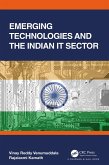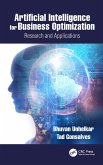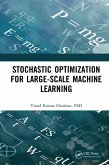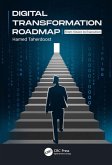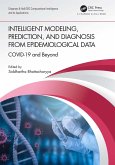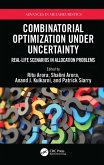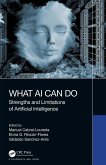Rajalaxmi Kamath, Vinay Reddy Venumuddala
Emerging Technologies and the Indian IT Sector (eBook, ePUB)
45,95 €
45,95 €
inkl. MwSt.
Sofort per Download lieferbar

23 °P sammeln
45,95 €
Als Download kaufen

45,95 €
inkl. MwSt.
Sofort per Download lieferbar

23 °P sammeln
Jetzt verschenken
Alle Infos zum eBook verschenken
45,95 €
inkl. MwSt.
Sofort per Download lieferbar
Alle Infos zum eBook verschenken

23 °P sammeln
Rajalaxmi Kamath, Vinay Reddy Venumuddala
Emerging Technologies and the Indian IT Sector (eBook, ePUB)
- Format: ePub
- Merkliste
- Auf die Merkliste
- Bewerten Bewerten
- Teilen
- Produkt teilen
- Produkterinnerung
- Produkterinnerung

Bitte loggen Sie sich zunächst in Ihr Kundenkonto ein oder registrieren Sie sich bei
bücher.de, um das eBook-Abo tolino select nutzen zu können.
Hier können Sie sich einloggen
Hier können Sie sich einloggen
Sie sind bereits eingeloggt. Klicken Sie auf 2. tolino select Abo, um fortzufahren.

Bitte loggen Sie sich zunächst in Ihr Kundenkonto ein oder registrieren Sie sich bei bücher.de, um das eBook-Abo tolino select nutzen zu können.
This book examines the implementation of emerging technology projects in the service-based Indian IT sector. It shows how emerging technologies impact IT enabled Services (ITeS) organizations and examines the mobility prospects for engineers and students looking to enter IT.
- Geräte: eReader
- mit Kopierschutz
- eBook Hilfe
Andere Kunden interessierten sich auch für
![Emerging Technologies and the Indian IT Sector (eBook, PDF) Emerging Technologies and the Indian IT Sector (eBook, PDF)]() Rajalaxmi KamathEmerging Technologies and the Indian IT Sector (eBook, PDF)45,95 €
Rajalaxmi KamathEmerging Technologies and the Indian IT Sector (eBook, PDF)45,95 €![Artificial Intelligence for Business Optimization (eBook, ePUB) Artificial Intelligence for Business Optimization (eBook, ePUB)]() Bhuvan UnhelkarArtificial Intelligence for Business Optimization (eBook, ePUB)46,95 €
Bhuvan UnhelkarArtificial Intelligence for Business Optimization (eBook, ePUB)46,95 €![Stochastic Optimization for Large-scale Machine Learning (eBook, ePUB) Stochastic Optimization for Large-scale Machine Learning (eBook, ePUB)]() Vinod Kumar ChauhanStochastic Optimization for Large-scale Machine Learning (eBook, ePUB)54,95 €
Vinod Kumar ChauhanStochastic Optimization for Large-scale Machine Learning (eBook, ePUB)54,95 €![Digital Transformation Roadmap (eBook, ePUB) Digital Transformation Roadmap (eBook, ePUB)]() Hamed TaherdoostDigital Transformation Roadmap (eBook, ePUB)46,95 €
Hamed TaherdoostDigital Transformation Roadmap (eBook, ePUB)46,95 €![Intelligent Modeling, Prediction, and Diagnosis from Epidemiological Data (eBook, ePUB) Intelligent Modeling, Prediction, and Diagnosis from Epidemiological Data (eBook, ePUB)]() Intelligent Modeling, Prediction, and Diagnosis from Epidemiological Data (eBook, ePUB)57,95 €
Intelligent Modeling, Prediction, and Diagnosis from Epidemiological Data (eBook, ePUB)57,95 €![Combinatorial Optimization Under Uncertainty (eBook, ePUB) Combinatorial Optimization Under Uncertainty (eBook, ePUB)]() Combinatorial Optimization Under Uncertainty (eBook, ePUB)46,95 €
Combinatorial Optimization Under Uncertainty (eBook, ePUB)46,95 €![What AI Can Do (eBook, ePUB) What AI Can Do (eBook, ePUB)]() What AI Can Do (eBook, ePUB)78,95 €
What AI Can Do (eBook, ePUB)78,95 €-
-
-
This book examines the implementation of emerging technology projects in the service-based Indian IT sector. It shows how emerging technologies impact IT enabled Services (ITeS) organizations and examines the mobility prospects for engineers and students looking to enter IT.
Dieser Download kann aus rechtlichen Gründen nur mit Rechnungsadresse in A, B, BG, CY, CZ, D, DK, EW, E, FIN, F, GR, HR, H, IRL, I, LT, L, LR, M, NL, PL, P, R, S, SLO, SK ausgeliefert werden.
Produktdetails
- Produktdetails
- Verlag: Taylor & Francis eBooks
- Seitenzahl: 128
- Erscheinungstermin: 30. März 2023
- Englisch
- ISBN-13: 9781000853759
- Artikelnr.: 67403212
- Verlag: Taylor & Francis eBooks
- Seitenzahl: 128
- Erscheinungstermin: 30. März 2023
- Englisch
- ISBN-13: 9781000853759
- Artikelnr.: 67403212
- Herstellerkennzeichnung Die Herstellerinformationen sind derzeit nicht verfügbar.
Vinay Reddy Venumuddala completed his PhD from Public Policy area, at the Indian Institute of Management Bangalore (IIMB). His research interests lie at the intersection of Information Systems, Public Policy, and Electrical and Electronics Engineering. Presently, he is working as a post-doctoral fellow at the Centre for Internet of Ethical Things, International Institute of Information Technology, Bangalore.
Rajalaxmi Kamath is an Associate Professor at the Center for Public Policy at the Indian Institute of Management Bangalore (IIMB). Her research is around issues facing the development of the Indian economy, post 2000 - microfinance and changing work conditions, with a very specific field oriented, grounds-up approach to understanding them.
Rajalaxmi Kamath is an Associate Professor at the Center for Public Policy at the Indian Institute of Management Bangalore (IIMB). Her research is around issues facing the development of the Indian economy, post 2000 - microfinance and changing work conditions, with a very specific field oriented, grounds-up approach to understanding them.
1. Introduction 1. Indian IT industry and transition to emerging
technologies 1.1 Transition to Emerging Technologies 1.2 Engineers and the
Indian IT services industry 2. Research objectives and Key findings 3.
Overview of Chapters 2. Research Context 1. Research Context - AI Research
Lab in an IT Services organization 1.1 ITSO's AI research lab 1.2 Work and
workforce in the AI research lab 1.3 Work ethnography in the AI research
lab 1.4 A Precursor study - ethnography in an engineering college 3.
Emerging Technology Work in an Indian IT Services Organization 1 Emerging
Technology solutions 1.1 Importance of a firm's business context in digital
transformation 1.2 Developing different emerging technology solutions 1.2.1
Internet of Things (IoT) 1.2.2 Blockchain 1.2.3 Artificial Intelligence
(AI) 2 Delivering Software vs Emerging Technology solutions 2.1 Delivering
software solutions 2.1.1 Principles guiding software development 2.1.2
Software development for Cloud 2.2 Comparison with Emerging Technologies
2.2.1 Maturity of development workflows 2.2.2 Work roles straddling between
activities 3. Client-centric AI solutions by ITSO's research lab 3.1 The
ethnographer's project in the AI research lab 3.2 Workflows negotiated for
AI projects 3.2.1 Use-case identification 3.2.2 Proof of concept 3.2.3
Execution and deployment 3.2.4 Post deployment 3.3 Dominance of software
engineering principles 4. Challenges in the transition towards emerging
technologies 4.1 Servicing lower end in the client's value chain 4.2
Difficulty in scaling-up the AI value chain 4.3 Unplanned WFH that
exacerbated challenges 4. The Indian IT industry and Emerging Technologies:
Mobility of Engineers 1 Role of Engineers in the Indian Industry 1.1
Engineers and Public Sector Employment 1.2 Demand from the IT industry and
Mushrooming of Private Engineering Colleges 1.3 Rising demand for emerging
technology workforce 2 AI research lab - work roles in an AI project 2.1
Business analysts - developing high-level frameworks 2.2 AI specific roles
- less of use-case-centric productionizing 2.3 Software roles - integration
and deployment 2.4 Data Scientists - building compatible workflows 3
Mobility prospects of beginner roles 3.1 Data engineers and their mobility
pathways 3.1.1 Data sciences and business understanding 3.1.2 Primacy of
programming skills 3.2 Cloud/software-engineers and their mobility pathways
3.2.1 Client-independent standard work requirements 3.3 Mobility challenges
of non-IT engineers - the IT and non-IT divide 4 IT vs non-IT divide -
manifesting in the engineering colleges 4.1 Lack of academic autonomy and
rigid disciplinary boundaries 4.2 A dominant influence of IT industry for
student placements 4.3 Students from non-IT disciplines and their
negotiated flexibility towards IT 4.4 Students from non-IT disciplines and
Emerging technology pursuits 5. Scope for substantive engagement of non-IT
engineers in the IT industry 5. Discussion 1 A summary of our findings 2
Relook at client-vendor relationships in the Indian IT sector 2.1 Influence
of clients on the nature of emerging technology work 2.2 Negotiating
factors for a newly evolving client-vendor relationship 3 Implications of
this study to the Indian IT industry and Policy 3.1 India's IT-led
innovations and the road ahead 3.2 Can the Indian IT services industry
unleash its abundant domain expertise? 3.3 Implications to industrial and
educational policy 4 Conclusion and Future Work 6. Theoretical Appendix 1
Critical Realism: The Philosophical Basis 1.1 Principles of Critical
Realism embedded in our work ethnography 1.2 Work Ethnography 2 Critical
Realism and Ethnography findings 2.1 Separation of Structure and Agency 2.2
Retroducing the hierarchical domains of the Real, Actual and Empirical 2.3
Some reflexions on our work ethnography 7. Further Readings
technologies 1.1 Transition to Emerging Technologies 1.2 Engineers and the
Indian IT services industry 2. Research objectives and Key findings 3.
Overview of Chapters 2. Research Context 1. Research Context - AI Research
Lab in an IT Services organization 1.1 ITSO's AI research lab 1.2 Work and
workforce in the AI research lab 1.3 Work ethnography in the AI research
lab 1.4 A Precursor study - ethnography in an engineering college 3.
Emerging Technology Work in an Indian IT Services Organization 1 Emerging
Technology solutions 1.1 Importance of a firm's business context in digital
transformation 1.2 Developing different emerging technology solutions 1.2.1
Internet of Things (IoT) 1.2.2 Blockchain 1.2.3 Artificial Intelligence
(AI) 2 Delivering Software vs Emerging Technology solutions 2.1 Delivering
software solutions 2.1.1 Principles guiding software development 2.1.2
Software development for Cloud 2.2 Comparison with Emerging Technologies
2.2.1 Maturity of development workflows 2.2.2 Work roles straddling between
activities 3. Client-centric AI solutions by ITSO's research lab 3.1 The
ethnographer's project in the AI research lab 3.2 Workflows negotiated for
AI projects 3.2.1 Use-case identification 3.2.2 Proof of concept 3.2.3
Execution and deployment 3.2.4 Post deployment 3.3 Dominance of software
engineering principles 4. Challenges in the transition towards emerging
technologies 4.1 Servicing lower end in the client's value chain 4.2
Difficulty in scaling-up the AI value chain 4.3 Unplanned WFH that
exacerbated challenges 4. The Indian IT industry and Emerging Technologies:
Mobility of Engineers 1 Role of Engineers in the Indian Industry 1.1
Engineers and Public Sector Employment 1.2 Demand from the IT industry and
Mushrooming of Private Engineering Colleges 1.3 Rising demand for emerging
technology workforce 2 AI research lab - work roles in an AI project 2.1
Business analysts - developing high-level frameworks 2.2 AI specific roles
- less of use-case-centric productionizing 2.3 Software roles - integration
and deployment 2.4 Data Scientists - building compatible workflows 3
Mobility prospects of beginner roles 3.1 Data engineers and their mobility
pathways 3.1.1 Data sciences and business understanding 3.1.2 Primacy of
programming skills 3.2 Cloud/software-engineers and their mobility pathways
3.2.1 Client-independent standard work requirements 3.3 Mobility challenges
of non-IT engineers - the IT and non-IT divide 4 IT vs non-IT divide -
manifesting in the engineering colleges 4.1 Lack of academic autonomy and
rigid disciplinary boundaries 4.2 A dominant influence of IT industry for
student placements 4.3 Students from non-IT disciplines and their
negotiated flexibility towards IT 4.4 Students from non-IT disciplines and
Emerging technology pursuits 5. Scope for substantive engagement of non-IT
engineers in the IT industry 5. Discussion 1 A summary of our findings 2
Relook at client-vendor relationships in the Indian IT sector 2.1 Influence
of clients on the nature of emerging technology work 2.2 Negotiating
factors for a newly evolving client-vendor relationship 3 Implications of
this study to the Indian IT industry and Policy 3.1 India's IT-led
innovations and the road ahead 3.2 Can the Indian IT services industry
unleash its abundant domain expertise? 3.3 Implications to industrial and
educational policy 4 Conclusion and Future Work 6. Theoretical Appendix 1
Critical Realism: The Philosophical Basis 1.1 Principles of Critical
Realism embedded in our work ethnography 1.2 Work Ethnography 2 Critical
Realism and Ethnography findings 2.1 Separation of Structure and Agency 2.2
Retroducing the hierarchical domains of the Real, Actual and Empirical 2.3
Some reflexions on our work ethnography 7. Further Readings
1. Introduction 1. Indian IT industry and transition to emerging
technologies 1.1 Transition to Emerging Technologies 1.2 Engineers and the
Indian IT services industry 2. Research objectives and Key findings 3.
Overview of Chapters 2. Research Context 1. Research Context - AI Research
Lab in an IT Services organization 1.1 ITSO's AI research lab 1.2 Work and
workforce in the AI research lab 1.3 Work ethnography in the AI research
lab 1.4 A Precursor study - ethnography in an engineering college 3.
Emerging Technology Work in an Indian IT Services Organization 1 Emerging
Technology solutions 1.1 Importance of a firm's business context in digital
transformation 1.2 Developing different emerging technology solutions 1.2.1
Internet of Things (IoT) 1.2.2 Blockchain 1.2.3 Artificial Intelligence
(AI) 2 Delivering Software vs Emerging Technology solutions 2.1 Delivering
software solutions 2.1.1 Principles guiding software development 2.1.2
Software development for Cloud 2.2 Comparison with Emerging Technologies
2.2.1 Maturity of development workflows 2.2.2 Work roles straddling between
activities 3. Client-centric AI solutions by ITSO's research lab 3.1 The
ethnographer's project in the AI research lab 3.2 Workflows negotiated for
AI projects 3.2.1 Use-case identification 3.2.2 Proof of concept 3.2.3
Execution and deployment 3.2.4 Post deployment 3.3 Dominance of software
engineering principles 4. Challenges in the transition towards emerging
technologies 4.1 Servicing lower end in the client's value chain 4.2
Difficulty in scaling-up the AI value chain 4.3 Unplanned WFH that
exacerbated challenges 4. The Indian IT industry and Emerging Technologies:
Mobility of Engineers 1 Role of Engineers in the Indian Industry 1.1
Engineers and Public Sector Employment 1.2 Demand from the IT industry and
Mushrooming of Private Engineering Colleges 1.3 Rising demand for emerging
technology workforce 2 AI research lab - work roles in an AI project 2.1
Business analysts - developing high-level frameworks 2.2 AI specific roles
- less of use-case-centric productionizing 2.3 Software roles - integration
and deployment 2.4 Data Scientists - building compatible workflows 3
Mobility prospects of beginner roles 3.1 Data engineers and their mobility
pathways 3.1.1 Data sciences and business understanding 3.1.2 Primacy of
programming skills 3.2 Cloud/software-engineers and their mobility pathways
3.2.1 Client-independent standard work requirements 3.3 Mobility challenges
of non-IT engineers - the IT and non-IT divide 4 IT vs non-IT divide -
manifesting in the engineering colleges 4.1 Lack of academic autonomy and
rigid disciplinary boundaries 4.2 A dominant influence of IT industry for
student placements 4.3 Students from non-IT disciplines and their
negotiated flexibility towards IT 4.4 Students from non-IT disciplines and
Emerging technology pursuits 5. Scope for substantive engagement of non-IT
engineers in the IT industry 5. Discussion 1 A summary of our findings 2
Relook at client-vendor relationships in the Indian IT sector 2.1 Influence
of clients on the nature of emerging technology work 2.2 Negotiating
factors for a newly evolving client-vendor relationship 3 Implications of
this study to the Indian IT industry and Policy 3.1 India's IT-led
innovations and the road ahead 3.2 Can the Indian IT services industry
unleash its abundant domain expertise? 3.3 Implications to industrial and
educational policy 4 Conclusion and Future Work 6. Theoretical Appendix 1
Critical Realism: The Philosophical Basis 1.1 Principles of Critical
Realism embedded in our work ethnography 1.2 Work Ethnography 2 Critical
Realism and Ethnography findings 2.1 Separation of Structure and Agency 2.2
Retroducing the hierarchical domains of the Real, Actual and Empirical 2.3
Some reflexions on our work ethnography 7. Further Readings
technologies 1.1 Transition to Emerging Technologies 1.2 Engineers and the
Indian IT services industry 2. Research objectives and Key findings 3.
Overview of Chapters 2. Research Context 1. Research Context - AI Research
Lab in an IT Services organization 1.1 ITSO's AI research lab 1.2 Work and
workforce in the AI research lab 1.3 Work ethnography in the AI research
lab 1.4 A Precursor study - ethnography in an engineering college 3.
Emerging Technology Work in an Indian IT Services Organization 1 Emerging
Technology solutions 1.1 Importance of a firm's business context in digital
transformation 1.2 Developing different emerging technology solutions 1.2.1
Internet of Things (IoT) 1.2.2 Blockchain 1.2.3 Artificial Intelligence
(AI) 2 Delivering Software vs Emerging Technology solutions 2.1 Delivering
software solutions 2.1.1 Principles guiding software development 2.1.2
Software development for Cloud 2.2 Comparison with Emerging Technologies
2.2.1 Maturity of development workflows 2.2.2 Work roles straddling between
activities 3. Client-centric AI solutions by ITSO's research lab 3.1 The
ethnographer's project in the AI research lab 3.2 Workflows negotiated for
AI projects 3.2.1 Use-case identification 3.2.2 Proof of concept 3.2.3
Execution and deployment 3.2.4 Post deployment 3.3 Dominance of software
engineering principles 4. Challenges in the transition towards emerging
technologies 4.1 Servicing lower end in the client's value chain 4.2
Difficulty in scaling-up the AI value chain 4.3 Unplanned WFH that
exacerbated challenges 4. The Indian IT industry and Emerging Technologies:
Mobility of Engineers 1 Role of Engineers in the Indian Industry 1.1
Engineers and Public Sector Employment 1.2 Demand from the IT industry and
Mushrooming of Private Engineering Colleges 1.3 Rising demand for emerging
technology workforce 2 AI research lab - work roles in an AI project 2.1
Business analysts - developing high-level frameworks 2.2 AI specific roles
- less of use-case-centric productionizing 2.3 Software roles - integration
and deployment 2.4 Data Scientists - building compatible workflows 3
Mobility prospects of beginner roles 3.1 Data engineers and their mobility
pathways 3.1.1 Data sciences and business understanding 3.1.2 Primacy of
programming skills 3.2 Cloud/software-engineers and their mobility pathways
3.2.1 Client-independent standard work requirements 3.3 Mobility challenges
of non-IT engineers - the IT and non-IT divide 4 IT vs non-IT divide -
manifesting in the engineering colleges 4.1 Lack of academic autonomy and
rigid disciplinary boundaries 4.2 A dominant influence of IT industry for
student placements 4.3 Students from non-IT disciplines and their
negotiated flexibility towards IT 4.4 Students from non-IT disciplines and
Emerging technology pursuits 5. Scope for substantive engagement of non-IT
engineers in the IT industry 5. Discussion 1 A summary of our findings 2
Relook at client-vendor relationships in the Indian IT sector 2.1 Influence
of clients on the nature of emerging technology work 2.2 Negotiating
factors for a newly evolving client-vendor relationship 3 Implications of
this study to the Indian IT industry and Policy 3.1 India's IT-led
innovations and the road ahead 3.2 Can the Indian IT services industry
unleash its abundant domain expertise? 3.3 Implications to industrial and
educational policy 4 Conclusion and Future Work 6. Theoretical Appendix 1
Critical Realism: The Philosophical Basis 1.1 Principles of Critical
Realism embedded in our work ethnography 1.2 Work Ethnography 2 Critical
Realism and Ethnography findings 2.1 Separation of Structure and Agency 2.2
Retroducing the hierarchical domains of the Real, Actual and Empirical 2.3
Some reflexions on our work ethnography 7. Further Readings

